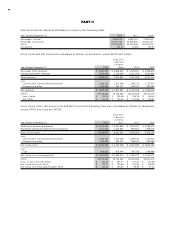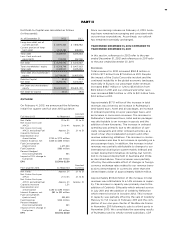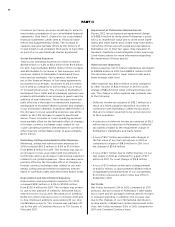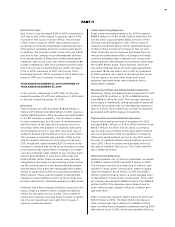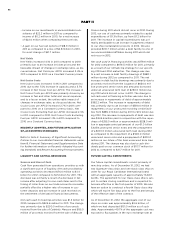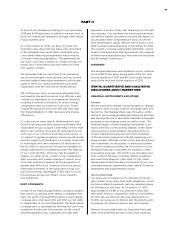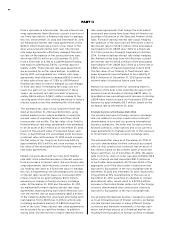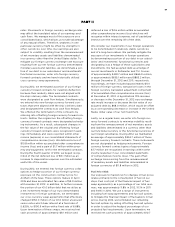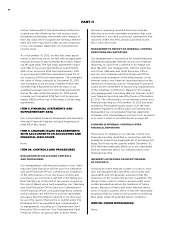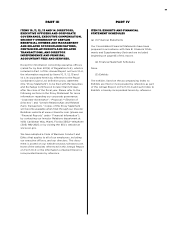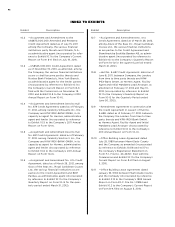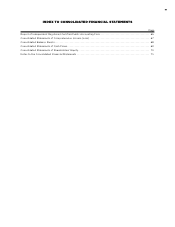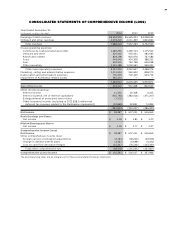Royal Caribbean Cruise Lines 2012 Annual Report Download - page 61
Download and view the complete annual report
Please find page 61 of the 2012 Royal Caribbean Cruise Lines annual report below. You can navigate through the pages in the report by either clicking on the pages listed below, or by using the keyword search tool below to find specific information within the annual report.
57
PART II
rates. Movements in foreign currency exchange rates
may affect the translated value of our earnings and
cash flows. We manage most of this exposure on a
consolidated basis, which allows us to take advantage
of any natural offsets. Therefore, weakness in one
particular currency might be offset by strengths in
other currencies over time. Our earnings are also
subject to volatility resulting from the remeasurement
of net monetary assets and liabilities denominated
in a currency other than the United States dollar. To
mitigate our foreign currency exchange rate exposure
resulting from our net foreign currency denominated
monetary assets and liabilities, we denominate a por-
tion of our debt in our subsidiaries’ and investments’
functional currencies, enter into foreign currency
forward contracts and we have historically utilized
cross currency swap agreements.
During 2012, we terminated a portion of our foreign
currency forward contracts for Celebrity Reflection
because their maturity dates were not aligned with
the ship’s delivery date. The terminated contracts
were designated as cash flow hedges. Simultaneously,
we entered into new foreign currency forward con-
tracts that were aligned with the ship’s delivery date
and designated the contracts as cash flow hedges.
We effected the termination of the contracts by
entering into offsetting foreign currency forward con-
tracts. Neither the original nor the offsetting foreign
currency forward contracts were designated as hedg-
ing instruments. As a result, subsequent changes in
the fair value of the original and offsetting foreign
currency forward contracts were recognized in earn-
ings immediately and were reported within other
income (expense) in our consolidated statements of
comprehensive income (loss). We deferred a loss of
$10.8 million within accumulated other comprehensive
income (loss) and a gain of $1.7 million within prop-
erty and equipment, net for the terminated contracts.
During the fourth quarter of 2012, we began recog-
nition of the net deferred loss of $9.1 million as an
increase to depreciation expense over the estimated
useful life of the vessel.
During 2012, we entered into foreign currency collar
options to hedge a portion of our foreign currency
exposure on the construction contract price for
Anthem of the Seas. These options mature in April
2015 and have an estimated fair value of $9.0 million
at December 31, 2012. In addition, to further increase
the portion of our €1.0 billion debt that we utilize as
a net investment hedge of our euro denominated
investments in foreign operations, we terminated
our cross currency swap agreements that effectively
changed €150.0 million of our €1.0 billion unsecured
senior notes which bear interest at a fixed rate of
5.625%, to $190.9 million with a fixed rate of 6.68%.
Upon termination of these swaps, we received net
cash proceeds of approximately $9.1 million and
deferred a loss of $2.6 million within accumulated
other comprehensive income (loss) which we will
recognize within interest expense, net of capitalized
interest over the remaining life of the debt.
We consider our investments in our foreign operations
to be denominated in relatively stable currencies
and of a long-term nature. We partially mitigate the
exposure of our investments in foreign operations
by denominating a portion of our debt in our subsid-
iaries’ and investments’ functional currencies and
designating it as a hedge of these subsidiaries and
investments. We had assigned debt as a hedge of
our net investments in Pullmantur and TUI Cruises
of approximately €481.7 million and €665.0 million,
or approximately $635.1 million and $863.2 million,
through December 31, 2012 and 2011, respectively.
Accordingly, we have included approximately $10.1
million of foreign-currency transaction losses in the
foreign currency translation adjustment component
of accumulated other comprehensive income (loss)
at December 31, 2012. A hypothetical 10% increase
or decrease in the December 31, 2012 euro exchange
rate would increase or decrease the fair value of our
assigned debt by $68.0 million, which would be offset
by a corresponding decrease or increase in the United
States dollar value of our net investment.
Lastly, on a regular basis, we enter into foreign cur-
rency forward contracts to minimize volatility result-
ing from the remeasurement of net monetary assets
and liabilities denominated in a currency other than
our functional currency or the functional currencies of
our foreign subsidiaries. During 2012, we maintained
an average of approximately $334.7 million of these
foreign currency forward contracts. These instruments
are not designated as hedging instruments. Foreign
currency forward contract gains of approximately
$7.7 million are recognized in earnings within other
income (expense) in our consolidated statements
of comprehensive income (loss). This gain offset
exchange losses arising from the remeasurement
of monetary assets and liabilities denominated in
foreign currencies of $11.8 million in 2012.
Fuel Price Risk
Our exposure to market risk for changes in fuel prices
relates primarily to the consumption of fuel on our
ships. Fuel cost (net of the financial impact of fuel
swap agreements), as a percentage of our total reve-
nues, was approximately 11.8% in 2012, 10.1% in 2011
and 9.6% in 2010. We use a range of instruments
including fuel swap agreements and fuel call options
to mitigate the financial impact of fluctuations in fuel
prices. During 2012, we terminated our remaining
fuel call options by selling offsetting fuel call options
in order to adjust the hedged percentage of our
projected fuel requirements. Upon termination, we
received net cash proceeds of approximately $10.7



